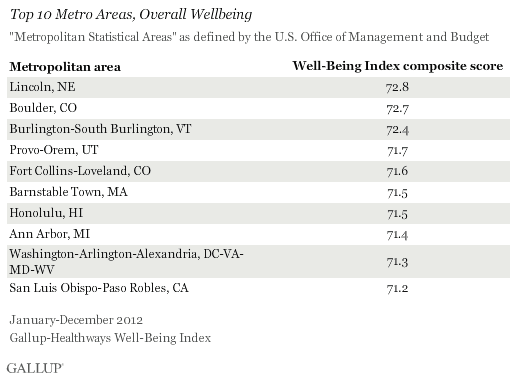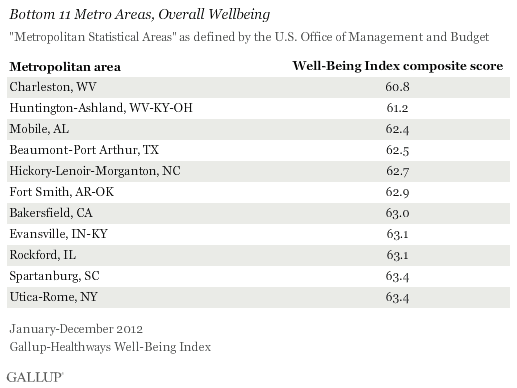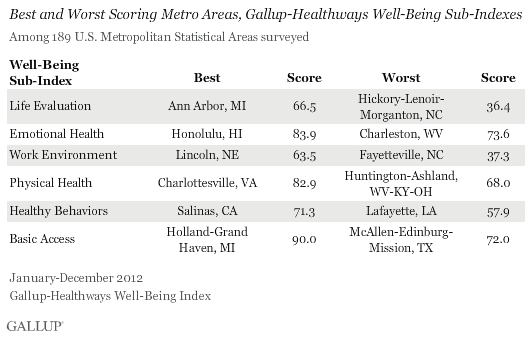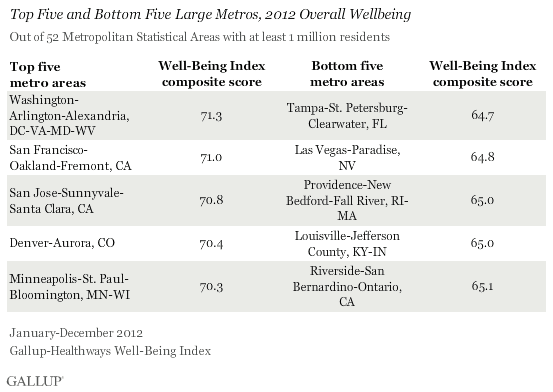WASHINGTON, D.C. -- Lincoln, Neb., had the highest Well-Being Index score (72.8) in the U.S. across the 189 metropolitan areas that Gallup and Healthways surveyed in 2012. Also in the top 10 are Boulder, Colo.; Provo-Orem, Utah; Ann Arbor, Mich.; Honolulu, Hawaii; Fort Collins-Loveland, Colo.; and Burlington-South Burlington, Vt.

At 60.8, Charleston, W.Va., had the lowest Well-Being Index score, displacing Huntington-Ashland, W.Va.-Ky.-Ohio, which held this position the two previous years. Huntington-Ashland's score of 61.2 is up from 58.1 in 2010, which is the lowest score on record for any metro area across five years of data collection. Mobile, Ala.; Utica-Rome, N.Y.; Hickory-Lenoir-Morganton, N.C.; and Fort Smith, Ark.-Okla.; join Charleston and Huntington-Ashland as frequent occupants of the bottom 10 list each year.

The regional breakdown in well-being scores is largely consistent with Gallup and Healthways state-level results, which find well-being generally higher in Western and Midwestern states and lower in Southern states. West Virginia, which has the two lowest-rated metro areas (Charleston and Huntington-Ashland) in the U.S., was ranked last in the nation among states for the fourth consecutive year in 2012.
The "cities" this article references are based on the Metropolitan Statistical Areas (MSAs) as defined by the U.S. Office of Management and Budget. In many cases, more than one city is included in the same MSA, and the same MSA can cross state borders. All reported MSAs encompass at least 300 completed surveys, and Gallup has weighted each of these MSA samples to ensure it is demographically representative of that MSA.
The Gallup-Healthways Well-Being Index score is an average of six sub-indexes, which individually examine life evaluation, emotional health, work environment, physical health, healthy behaviors, and access to basic necessities. The overall score and each of the six sub-index scores are calculated on a scale from 0 to 100, where a score of 100 represents the ideal. Gallup and Healthways have been tracking these measures daily since January 2008.
Ann Arbor No. 1 in Life Evaluation Again; Honolulu Best Off Emotionally
Residents of Ann Arbor rate their current and future lives the best and residents of Hickory-Lenoir-Morganton rate theirs the worst, giving the two cities the highest and lowest Life Evaluation Index scores in the nation for the second year in a row, respectively.
Honolulu again led the nation with the best Emotional Health Index score. Charlottesville, Va., displaced Fort Collins, Colo., with the highest Physical Health Index score in the nation. Lincoln, Neb., had the highest Work Environment Index score, and residents living in Salinas, Calif., had the highest Healthy Behaviors Index score. Holland-Grand Haven, Mich., led the nation in access to basic necessities as it did in 2008-2010. (Gallup did not conduct enough surveys in Holland-Grand Haven to report on it in 2011.)

Residents of Hickory-Lenoir-Morganton rated their lives about half as well as those in Ann Arbor. Elsewhere in North Carolina, residents of Fayetteville similarly reported roughly half of the workplace well-being found in Lincoln.
Huntington-Ashland residents again reported the worst physical health, although the city's score of 68.0 is an improvement over the 64.6 measured in 2010. These results align with West Virginia's position as the state with the highest obesity rate.
Charleston, W.Va., had the worst Emotional Health Index score, with Huntington-Ashland coming in second-worst for the second consecutive year. Healthy behaviors were least prevalent in Lafayette, La.
McAllen-Edinburg-Mission, Texas, residents reported the worst access to basic necessities for the fourth year in a row, due in part to 50% of residents who reported lacking health insurance, by far the lowest healthcare coverage rate in the nation. The U.S. metro area with the lowest score on the Basic Access Index has come from the state of Texas in all five years of measurement.
Washington, D.C., and San Francisco Top All Large Cities in Well-Being
Washington, D.C.-Arlington-Alexandria, Va.-Md.-W.Va., residents reported the highest well-being among the nation's 52 largest metropolitan areas, defined as those with 1 million residents or more, followed by San Francisco-Oakland-Fremont, Calif. These two metros have been in the top five among large metro areas in each of the past five years.
Tampa-St. Petersburg-Clearwater, Fla., displaced Las Vegas-Paradise, Nev., for the large metro area with the lowest well-being, due mostly to low life evaluations and emotional health scores. Las Vegas-Paradise residents again reported the worst access to clean and safe water in the U.S. among large cities -- a recurring characteristic for this metro area and a principle reason why it ranks last nationally among large metro areas in basic access for the fifth-straight year. In general, though, the gaps in well-being between the highest and lowest rated large metro areas are not as large as the gaps found between all cities.

Implications
High well-being cities tend to exhibit many shared characteristics, including positive health and well-being outcomes -- like low chronic disease rates and high life ratings -- and behaviors such as frequent exercise and less smoking. These commonalities consistently demonstrate a mutual foundation upon which the top cities ascertain and maintain their status as standard bearers of well-being in America.
Compared to low well-being cities, residents of high well-being cities usually have much lower rates of obesity, high blood pressure, diabetes, and physical pain. They rate their lives higher today and in the future, and are much more likely to think that the city or area where they reside is "getting better as a place to live." They are more likely to have enough money for food, medicine, and shelter. They are less likely to be depressed and are more likely to report positive workplaces.
The behaviors and choices occupants of high well-being cities make also distinguish them from their low well-being counterparts, and can serve as a good example for the leaders of other cities to pursue in their own communities. For example, residents of high well-being cities exercise more, but their leaders also create more safe places for people to go to exercise. They eat more fruits and vegetables, but their leaders also establish safer, more readily accessible places to access their produce. They are more likely to have health insurance and to go to the dentist, but they also have leaders who help ensure that all have enough money for healthcare. And residents in high well-being cities are less likely to carry sadness on any given day, but also live in communities where their leaders afford them more opportunities to learn and do interesting things. The fact that many of the highest well-being cities continue to be university towns or cities with a robust academic presence may not be a coincidence, given the potential that local colleges can have on the local culture of well-being.
High well-being cities such as Lincoln, Boulder, Burlington-South Burlington, Provo-Orem, and Fort Collins-Loveland provide models to emulate and goals for others to aspire to, including the many U.S. metro areas that lag far behind in health and well-being.
About the Gallup-Healthways Well-Being Index
The Gallup-Healthways Well-Being Index tracks well-being in the U.S. and provides best-in-class solutions for a healthier world. To learn more, please visit well-beingindex.com.
Survey Methods
Results are based on telephone interviews conducted as part of the Gallup-Healthways Well-Being Index survey Jan. 2-Dec. 29, 2012, with a random sample of 353,563 adults, aged 18 and older, living in all 50 U.S. states and the District of Columbia, selected using random-digit-dial sampling.
The metro areas referenced in this article are based on the Metropolitan Statistical Areas (MSAs) as defined by the U.S. Office of Management and Budget. In many cases, more than one city is included in the same MSA. The San Jose, Calif., metropolitan statistical area, for example, also includes the smaller nearby cities of Sunnyvale and Santa Clara in addition to San Jose itself. Each respondent is attributed to his or her MSA based on the self-report of his or her ZIP code, and all metro areas had at least 300 completed surveys in 2011.
Maximum expected error ranges for the MSAs vary according to size, ranging from less than 1 percentage point for the largest cities represented to ±6.5 percentage points for the smallest cities.
Interviews are conducted with respondents on landline telephones and cellular phones, with interviews conducted in Spanish for respondents who are primarily Spanish-speaking. Each sample includes a minimum quota of 400 cellphone respondents and 600 landline respondents per 1,000 national adults, with additional minimum quotas among landline respondents by region. Landline telephone numbers are chosen at random among listed telephone numbers. Cellphone numbers are selected using random-digit-dial methods. Landline respondents are chosen at random within each household on the basis of which member had the most recent birthday.
Samples are weighted by gender, age, race, Hispanic ethnicity, education, region, adults in the household, and phone status (cellphone only/landline only/both, cellphone mostly, and having an unlisted landline number). Demographic weighting targets are based on the March 2011 Current Population Survey figures for the aged 18 and older non-institutionalized population (through November 30 and all aged 18 and older beginning in December), living in U.S. telephone households. All reported margins of sampling error include the computed design effects for weighting and sample design.
In addition to sampling error, question wording and practical difficulties in conducting surveys can introduce error or bias into the findings of public opinion polls.
For more details on Gallup's polling methodology, visit https://www.gallup.com/.
